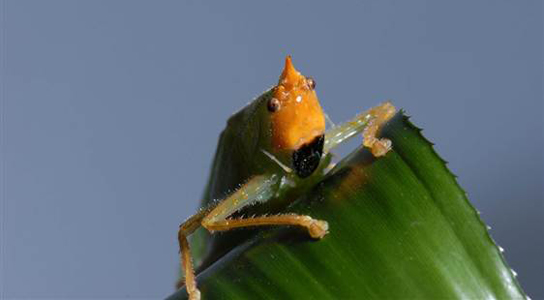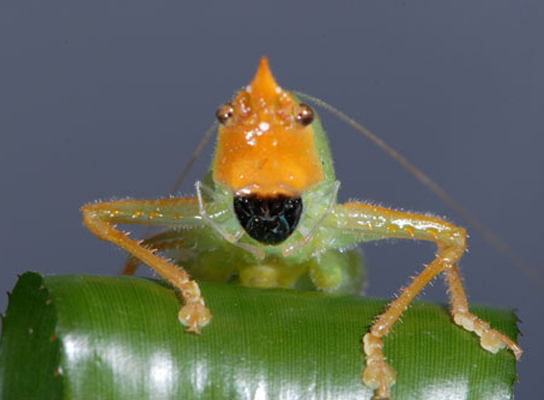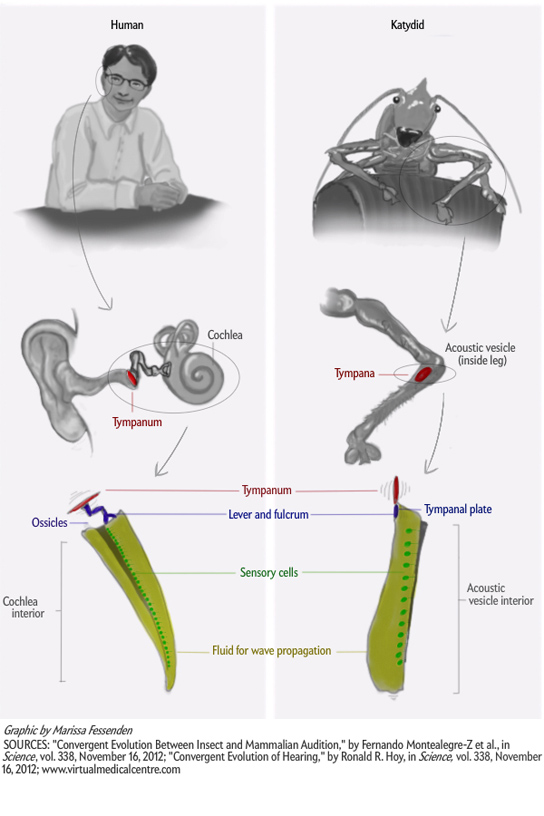
Copiphora gorgonensis, a South American katydid found to have remarkably human-like ears. Credit: Photo by Daniel Robert and Fernando Montealegre-Zapata
Katydid ears have evolved components resembling those of human ears, on a smaller scale. This is an example of convergent evolution.
The scientists published their findings in the journal Science. Katydids are part of the family Tettigoniidae, which encompasses more than 6,400 species. A kind of rainforest katydid has ears that are remarkably similar to those of humans and other mammals. The ears are tucked in the crook of its front legs, and have components that echo the structures of the human middle and inner ear.

Female Copiphora gorgonensis (Insecta: Orthoptera: Tettigoniidae), a nocturnal bush cricket from the Colombian National Natural Park Gorgona Island, standing on a bromeliad leaf. Credit: Photo by Daniel Robert and Fernando Montealegre-Zapata
In the human ear, the outer portion of the ear gathers sound waves and funnels them toward the tympanic membrane. Its vibrations translate the pressure waves of the sound to the hammer, anvil, and stirrup bones which shake against the cochlea, whose curves are lined with sensory-cell hairs. The wiggling bones outside jiggle liquid inside the organ and trigger the cells, which send signals to the brain via the auditory nerve. Hair cells responding to higher frequencies are closer to the origin of the wave’s propagation, and cells that respond to low frequencies are located deeper within the cochlea.
Copiphora gorgonensis, a yellow- and orange-faced katydid that inhabits Gorgona Island in Columbia, has a hearing organ that uses a tympanic membrane that connects to a thin cuticle plate. Sound waves move the tympanum and the cuticle plate like a seesaw. This translates larger movements from air pressure to smaller, more powerful motions in the cuticle plate. Then, the plate creates ripples in a fluid-filled chamber. Inside the chamber, there are sensory cells arranged from high- to low-frequency sensitivity.
While the katydid’s ear spans just 600 microns, the cuticle plate plays the same role as the hammer, anvil, and stirrup in mammalian ears. C. gorgonesis‘s evolved ear helps it to avoid predators. These katydids communicate in the ultrasound frequency range, which is much too high for most organisms, and most potential predators. The sensory cells respond from 10 to 50 kilohertz. Katydids sing at around 23 kilohertz. For now, katydids are the only insects with this kind of ear.

Reference: “Convergent Evolution Between Insect and Mammalian Audition” by Fernando Montealegre-Z., Thorin Jonsson, Kate A. Robson-Brown, Matthew Postles and Daniel Robert, 16 November 2012, Science.
DOI: 10.1126/science.1225271









So what your saying is the auditory response is the same 20hz- 20kHz. How about the response selectivity and Sensitivity from the Chochlea and Veside interior?